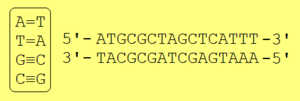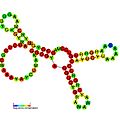Complementarity (molecular biology) facts for kids

In molecular biology, complementarity is a special property of nucleic acids like DNA and RNA. Think of it like a puzzle where each piece has a perfect match. In DNA and RNA, each nucleotide has a part called a nitrogenous base. These bases can only pair up with specific other bases. When they match perfectly, we say they are complementary. These pairs are held together by weak connections called hydrogen bonds.
Because each base has only one specific partner, enzymes can easily create a new matching strand from a single existing strand. This process is super important for things like DNA replication, which is how your body makes new copies of DNA when cells divide.
How Bases Pair Up
In DNA, the bases that are complementary and always pair together are:
For example, if you have a DNA strand with the sequence:
A G T C A T G
Its complementary (matching) strand would be:
T C A G T A C
This precise pairing is what allows DNA to store and copy genetic information accurately.
Why is Complementarity Important?
The ability of DNA bases to pair up in a specific way is vital for life. It's how your cells can make exact copies of your DNA every time a cell divides. This process, called DNA replication, ensures that new cells get a complete and correct set of genetic instructions. Without complementarity, DNA couldn't be copied accurately, and life as we know it wouldn't be possible!
Images for kids
See also
 In Spanish: Complementariedad (biología molecular) para niños
In Spanish: Complementariedad (biología molecular) para niños




